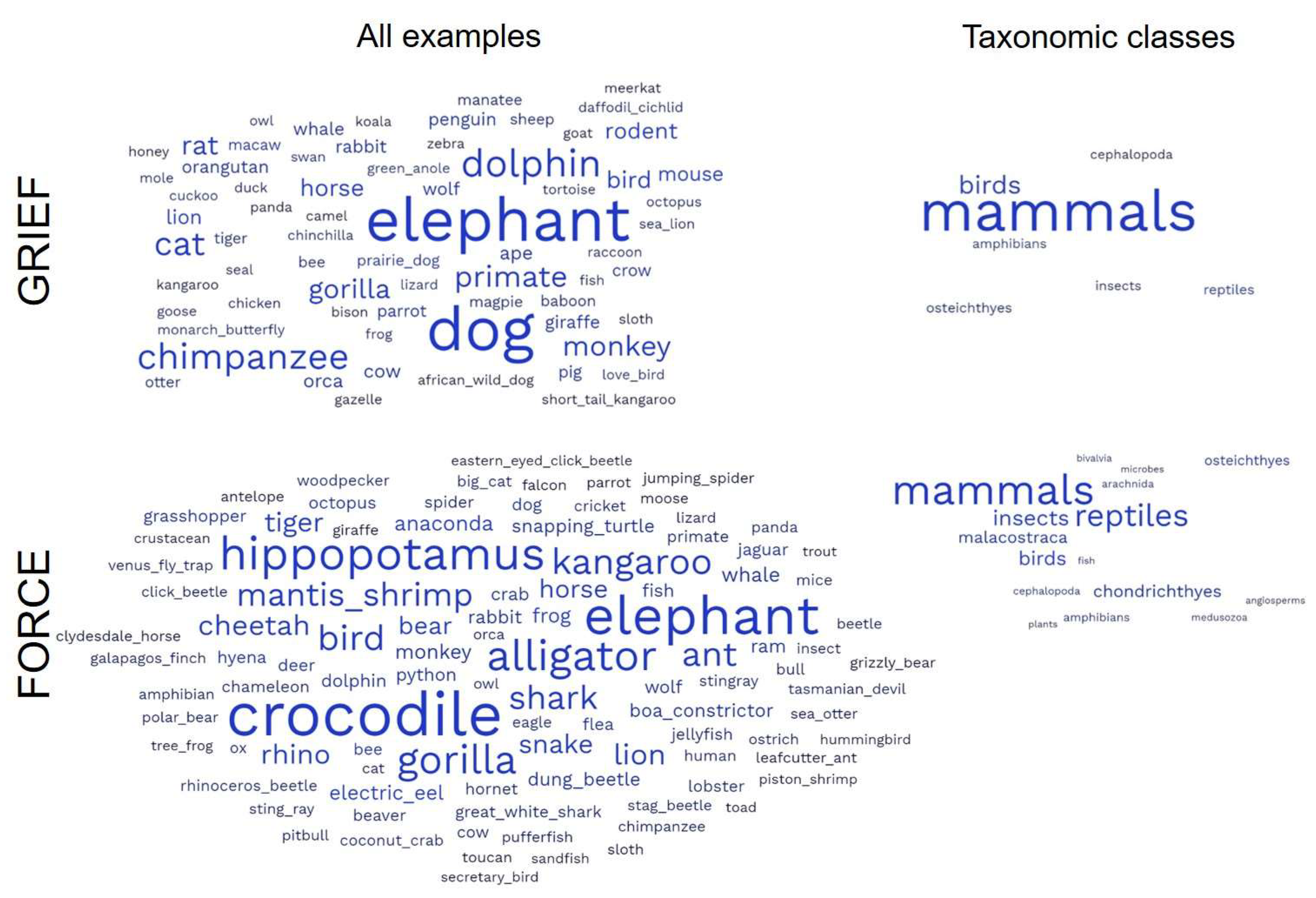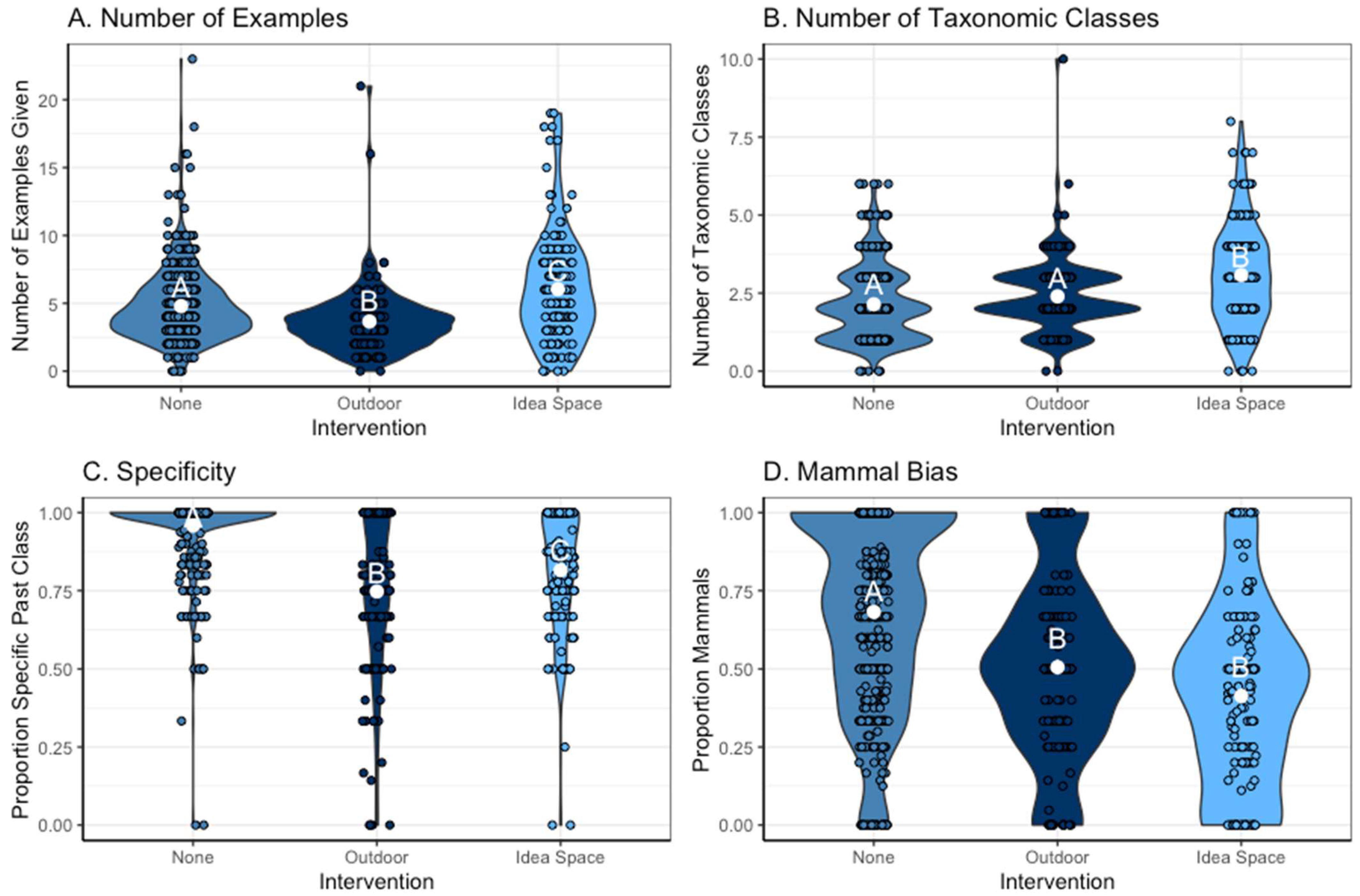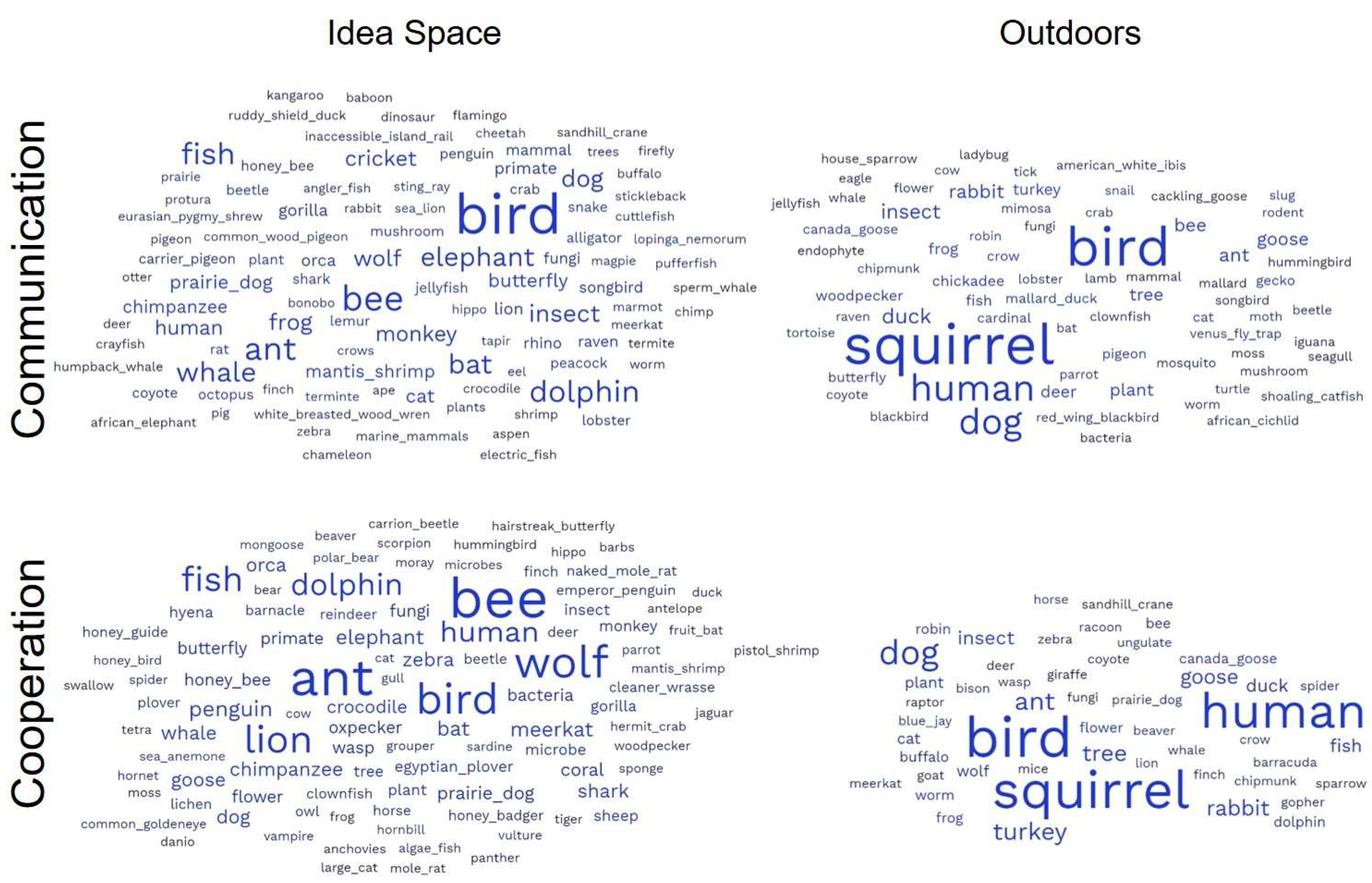Broadening the Taxonomic Breadth of Organisms in the Bio-Inspired Design Process
Abstract
1. Introduction
2. Methods
2.1. Course Details
2.2. Assignment Design
2.3. Prior Knowledge and Learning from Team Members
2.4. Outdoor and Idea-Space Interventions
2.5. Assessment of Divergent Thinking
2.6. IRB Approval
2.7. Assessment of Student Engagement
2.8. Statistical Analyses
3. Results
3.1. Overview of Assignment Participation
3.2. Effects of Prompt and Practice
3.3. Effects of Individual and Team Member Familiarity with Biodiversity
3.4. Idea-Space and Outdoor Interventions
4. Discussion
4.1. Findings
4.2. Recommendations and Limitations
4.3. Future Research
4.4. Conclusions
Supplementary Materials
Author Contributions
Funding
Institutional Review Board Statement
Data Availability Statement
Acknowledgments
Conflicts of Interest
References
- Lepora, N.F.; Verschure, P.; Prescott, T.J. The state of the art in biomimetics. Bioinspiration Biomim. 2013, 8, 013001. [Google Scholar] [CrossRef] [PubMed]
- Bonser, R.H.C.; Vincent, J.F.V. Technology trajectories, innovation, and the growth of biomimetics. Proc. Inst. Mech. Eng. Part C J. Mech. Eng. Sci. 2007, 221, 1177–1180. [Google Scholar] [CrossRef]
- Goel, A.K.; McAdams, D.A.; Stone, R.B. Biologically Inspired Design; Springer: Berlin/Heidelberg, Germany, 2015. [Google Scholar]
- Farzaneh, H.H.; Lindemann, U. A practical Guide to Bio-Inspired Design; Springer: Berlin/Heidelberg, Germany, 2018. [Google Scholar]
- Fan, W.; Zeng, J.; Gan, Q.Q.; Ji, D.X.; Song, H.M.; Liu, W.Z.; Shi, L.; Wu, L.M. Iridescence-controlled and flexibly tunable retroreflective structural color film for smart displays. Sci. Adv. 2019, 5, eaaw8755. [Google Scholar] [CrossRef] [PubMed]
- Chung, K.; Yu, S.; Heo, C.J.; Shim, J.W.; Yang, S.M.; Han, M.G.; Lee, H.S.; Jin, Y.; Lee, S.Y.; Park, N.; et al. Flexible, Angle-Independent, Structural Color Reflectors Inspired by Morpho Butterfly Wings. Adv. Mater. 2012, 24, 2375–2379. [Google Scholar] [CrossRef]
- Modabberifar, M.; Spenko, M. Development of a gecko-like robotic gripper using Scott-Russell mechanisms. Robotica 2020, 38, 541–549. [Google Scholar] [CrossRef]
- Northen, M.T.; Greiner, C.; Arzt, E.; Turner, K.L. A Gecko-Inspired Reversible Adhesive. Adv. Mater. 2008, 20, 3905–3909. [Google Scholar] [CrossRef]
- Snell-Rood, E. Bring biologists into biomimetics. Nature 2016, 529, 277–278. [Google Scholar] [CrossRef]
- Ng, L.; Elgar, M.A.; Stuart-Fox, D. From Bioinspired to Bioinformed: Benefits of Greater Engagement From Biologists. Front. Ecol. Evol. 2021, 9, 790270. [Google Scholar] [CrossRef]
- Graeff, E.; Maranzana, N.; Aoussat, A. Biomimetics, where are the biologists? J. Eng. Des. 2019, 30, 289–310. [Google Scholar] [CrossRef]
- Jacobs, S.R.; Nichol, E.C.; Helms, M.E. “Where Are We Now and Where Are We Going?” The BioM Innovation Database. J. Mech. Des. 2014, 136, 111101. [Google Scholar] [CrossRef]
- Penick, C.A.; Cope, G.; Morankar, S.; Mistry, Y.; Grishin, A.; Chawla, N.; Bhate, D. The Comparative Approach to Bio-Inspired Design: Integrating Biodiversity and Biologists into the Design Process. Integr. Comp. Biol. 2022, 62, 1153–1163. [Google Scholar] [CrossRef] [PubMed]
- Scali, M.; Breedveld, P.; Dodou, D. Experimental evaluation of a self-propelling bio-inspired needle in single- and multi-layered phantoms. Sci. Rep. 2019, 9, 1–13. [Google Scholar] [CrossRef] [PubMed]
- Han, Z.W.; Mu, Z.Z.; Yin, W.; Li, W.; Niu, S.C.; Zhang, J.Q.; Ren, L.Q. Biomimetic multifunctional surfaces inspired from animals. Adv. Colloid Interface Sci. 2016, 234, 27–50. [Google Scholar] [CrossRef]
- Kirya, P.; Chen, E.; Achterman, M.; Eugenio, K.; Beshir, Z.; Ngoy, N.; Siddique, R.H.; Cakmak, A.O.; Ashcroft, J. Biomimicry of Blue Morpho butterfly wings: An introduction to nanotechnology through an interdisciplinary science education module. J. Soc. Inf. Disp. 2021, 29, 896–915. [Google Scholar] [CrossRef]
- Prum, R.O.; Quinn, T.; Torres, R.H. Anatomically diverse butterfly scales all produce structural colours by coherent scattering. J. Exp. Biol. 2006, 209, 748–765. [Google Scholar] [CrossRef] [PubMed]
- Thayer, R.C.; Allen, F.I.; Patel, N.H. Structural color in Junonia butterflies evolves by tuning scale lamina thickness. elife 2020, 9, e52187. [Google Scholar] [CrossRef]
- Blount, Z.D.; Borland, C.Z.; Lenski, R.E. Historical contingency and the evolution of a key innovation in an experimental population of Escherichia coli. Proc. Natl. Acad. Sci. USA 2008, 105, 7899–7906. [Google Scholar] [CrossRef] [PubMed]
- Hoffmann, A.; Donoghue, M.; Levin, S.; Mackay, T.; Rieseberg, L.; Travis, J.; Wray, G. Evolutionary limits and constraints. Princet. Guide Evol. 2014, 247–252. [Google Scholar]
- Fish, F.E.; Beneski, J.T. Evolution and bio-inspired design: Natural limitations. In Biologically Inspired Design; Springer: Berlin/Heidelberg, Germany, 2014; pp. 287–312. [Google Scholar]
- Shubin, N. Your Inner Fish: A Journey into the 3.5-Billion-Year History of the Human Body; Vintage: New York, NY, USA, 2008. [Google Scholar]
- Agrawal, A.A. Toward a Predictive Framework for Convergent Evolution: Integrating Natural History, Genetic Mechanisms, and Consequences for the Diversity of Life. Am. Nat. 2017, 190, S1–S12. [Google Scholar] [CrossRef]
- Sorensen, M.E.S.; Wood, A.J.; Minter, E.J.A.; Lowe, C.D.; Cameron, D.D.; Brockhurst, M.A. Comparison of Independent Evolutionary Origins Reveals Both Convergence and Divergence in the Metabolic Mechanisms of Symbiosis. Curr. Biol. 2020, 30, 328–334. [Google Scholar] [CrossRef]
- Rosenblum, E.B.; Parent, C.E.; Brandt, E.E. The Molecular Basis of Phenotypic Convergence. Annu. Rev. Ecol. Evol. Syst. 2014, 45, 203–226. [Google Scholar] [CrossRef]
- Runco, M.A. Creativity. Annu. Rev. Psychol. 2004, 55, 657–687. [Google Scholar] [CrossRef]
- Hennessey, B.A.; Amabile, T.M. Creativity. Annu. Rev. Psychol. 2010, 61, 569–598. [Google Scholar] [CrossRef]
- Runco, M.A.; Acar, S. Divergent Thinking as an Indicator of Creative Potential. Creat. Res. J. 2012, 24, 66–75. [Google Scholar] [CrossRef]
- Chou, A.; Shu, L.H. Using analogies to explain versus inspire concepts. Ai Edam-Artif. Intell. Eng. Des. Anal. Manuf. 2015, 29, 135–146. [Google Scholar] [CrossRef]
- Fu, K.; Moreno, D.; Yang, M.; Wood, K.L. Bio-Inspired Design: An Overview Investigating Open Questions from the Broader Field of Design-by-Analogy. J. Mech. Des. 2014, 136, 111102. [Google Scholar] [CrossRef]
- Deldin, J.-M.; Schuknecht, M. The AskNature database: Enabling solutions in biomimetic design. In Biologically Inspired Design; Springer: Berlin/Heidelberg, Germany, 2014; pp. 17–27. [Google Scholar]
- Vandevenne, D.; Pieters, T.; Duflou, J.R. Enhancing novelty with knowledge-based support for Biologically-Inspired Design. Des. Stud. 2016, 46, 152–173. [Google Scholar] [CrossRef]
- Graeff, E.; Maranzana, N.; Aoussat, A. Role of biologists in biomimetic design processes: Preliminary results. In Proceedings of DS 92: Proceedings of the DESIGN 2018 15th International Design Conference; pp. 1149–1160.
- Hallihan, G.M.; Shu, L.H. Considering Confirmation Bias in Design and Design Research. J. Integr. Des. Process Sci. 2013, 17, 19–35. [Google Scholar] [CrossRef]
- Osterblom, H.; Scheffer, M.; Westley, F.R.; van Esso, M.L.; Miller, J.; Bascompte, J. A message from magic to science: Seeing how the brain can be tricked may strengthen our thinking. Ecol. Soc. 2015, 20, 16. [Google Scholar] [CrossRef]
- Olsen, I.M. Beyond Taxonomic Bias in Extinction Discourse: Endangerment, Alterity, and Noncharismatic Species in Annie Proulx’s Barkskins and Orson Scott Card’s Ender’s Game. Isle-Interdiscip. Stud. Lit. Environ. 2021, isab001. [Google Scholar] [CrossRef]
- Colleony, A.; Clayton, S.; Couvet, D.; Saint Jalme, M.; Prevot, A.C. Human preferences for species conservation: Animal charisma trumps endangered status. Biol. Conserv. 2017, 206, 263–269. [Google Scholar] [CrossRef]
- Baruah, J.; Paulus, P.B. The Role of Time and Category Relatedness in Electronic Brainstorming. Small Group Res. 2016, 47, 333–342. [Google Scholar] [CrossRef]
- Scott, G.; Leritz, L.E.; Mumford, M.D. The effectiveness of creativity training: A quantitative review. Creat. Res. J. 2004, 16, 361–388. [Google Scholar] [CrossRef]
- Beaty, R.E.; Silvia, P.J. Why Do Ideas Get More Creative Across Time? An Executive Interpretation of the Serial Order Effect in Divergent Thinking Tasks. Psychol. Aesthet. Creat. Arts 2012, 6, 309–319. [Google Scholar] [CrossRef]
- Sun, J.Z.; Chen, Q.L.; Zhang, Q.L.; Li, Y.D.; Li, H.J.; Wei, D.T.; Yang, W.J.; Qiu, J. Training your brain to be more creative: Brain functional and structural changes induced by divergent thinking training. Hum. Brain Mapp. 2016, 37, 3375–3387. [Google Scholar] [CrossRef]
- Ericsson, K.A.; Krampe, R.T.; Teschromer, C. The role of deliberate practice in the acquisition of expert performance. Psychol. Rev. 1993, 100, 363–406. [Google Scholar] [CrossRef]
- Hundschell, A.; Razinskas, S.; Backmann, J.; Hoegl, M. The effects of diversity on creativity: A literature review and synthesis. Appl. Psychol.-Int. Rev.-Psychol. Appl.-Rev. Int. 2022, 71, 1598–1634. [Google Scholar] [CrossRef]
- Han, J.; Brass, D.J. Human capital diversity in the creation of social capital for team creativity. J. Organ. Behav. 2014, 35, 54–71. [Google Scholar] [CrossRef]
- Park, J.Y.; Im, I.; Sung, C.S. Is social networking a waste of time? The impact of social network and knowledge characteristics on job performance. Knowl. Manag. Res. Pract. 2017, 15, 560–571. [Google Scholar] [CrossRef]
- Bodla, A.A.; Tang, N.Y.; Jiang, W.; Tian, L.W. Diversity and creativity in cross-national teams: The role of team knowledge sharing and inclusive climate. J. Manag. Organ. 2018, 24, 711–729. [Google Scholar] [CrossRef]
- McCoy, J.M.; Evans, G.W. The potential role of the physical environment in fostering creativity. Creat. Res. J. 2002, 14, 409–426. [Google Scholar] [CrossRef]
- Atchley, R.A.; Strayer, D.L.; Atchley, P. Creativity in the Wild: Improving Creative Reasoning through Immersion in Natural Settings. PLoS ONE 2012, 7, e51474. [Google Scholar] [CrossRef] [PubMed]
- Snell-Rood, E.; Smirnoff, D.; Cantrell, H.; Chapman, K.; Kirscht, E.; Stretch, E. Bioinspiration as a method of problem-based STEM education: A case study with a class structured around the COVID-19 crisis. Ecol. Evol. 2021, 11, 16374–16386. [Google Scholar] [CrossRef] [PubMed]
- Hund, A.; Stretch, E.; Smirnoff, D.; Roehrig, G.; Snell-Rood, E. Broadening the taxonomic breadth of organisms in the bio-inspired design process. Mendeley Data 2023, V1. [Google Scholar] [CrossRef]
- Bates, D.; Machler, M.; Bolker, B.M.; Walker, S.C. Fitting Linear Mixed-Effects Models Using lme4. J. Stat. Softw. 2015, 67, 1–48. [Google Scholar] [CrossRef]
- Mansfield, R.S.; Busse, T.V.; Krepelka, E.J. The effectiveness of creativity training. Rev. Educ. Res. 1978, 48, 517–536. [Google Scholar] [CrossRef]
- West, M.A. Sparkling fountains or stagnant ponds: An integrative model of creativity and innovation implementation in work groups. Appl. Psychol.-Int. Rev.-Psychol. Appl.-Rev. Int. 2002, 51, 355–387. [Google Scholar] [CrossRef]
- Park, W.W.; Lew, J.Y.; Lee, E.K. Team knowledge diversity and team creativity: The moderating role of status inequality. Soc. Behav. Personal. 2018, 46, 1611–1622. [Google Scholar] [CrossRef]
- Garcia-Buades, M.E.; Peiro, J.M.; Montanez-Juan, M.I.; Kozusznik, M.W.; Ortiz-Bonnin, S. Happy-Productive Teams and Work Units: A Systematic Review of the ‘Happy-Productive Worker Thesis’. Int. J. Environ. Res. Public Health 2020, 17, 69. [Google Scholar] [CrossRef]
- Men, C.H.; Fong, P.; Luo, J.L.; Zhong, J.; Huo, W.W. When and how knowledge sharing benefits team creativity: The importance of cognitive team diversity. J. Manag. Organ. 2019, 25, 807–824. [Google Scholar] [CrossRef]
- Harrison, D.A.; Mohammed, S.; McGrath, J.E.; Florey, A.T.; Vanderstoep, S.W. Time matters in team performance: Effects of member familiarity, entrainment, and task discontinuity on speed and quality. Pers. Psychol. 2003, 56, 633–669. [Google Scholar] [CrossRef]
- Zhang, Y. Functional Diversity and Group Creativity: The Role of Group Longevity. J. Appl. Behav. Sci. 2016, 52, 97–123. [Google Scholar] [CrossRef]
- Michinov, N. Is Electronic Brainstorming or Brainwriting the Best Way to Improve Creative Performance in Groups? An Overlooked Comparison of Two Idea-Generation Techniques. J. Appl. Soc. Psychol. 2012, 42, E222–E243. [Google Scholar] [CrossRef]
- Edwards, G. Discomfort as Creative Fuel. In The Creativity Workbook for Coaches and Creatives; Routledge: Boca Raton, FL, USA, 2020; pp. 24–27. [Google Scholar]
- Jurik, R.A. The Outdoors: An Environmental Condition to Nurture Creative Thinking. Master’s Thesis, ERIC Clearinghouse, Penn State University, Washington, DC, USA, 1972. [Google Scholar]
- Alderton, D. Animal Grief-How Animals Mourn; Veloce Publishing Ltd.: Poundbury, UK, 2011. [Google Scholar]
- Patek, S.N. The Power of Mantis Shrimp Strikes: Interdisciplinary Impacts of an Extreme Cascade of Energy Release. Integr. Comp. Biol. 2019, 59, 1573–1585. [Google Scholar] [CrossRef]





| Problem | Some of the Framing Used in the Course to Provide Context |
|---|---|
| Force | How do we build machines capable of generating extreme forces (e.g., to use in demolition) that do not harm the user? (e.g., vibration syndrome) |
| Anxiety | How do we address anxiety within the mental health crisis? How do we tamp down excess fear and chronic stress in modern life? |
| Grief | How can we help people to process the loss of a loved one? How do we move past grief that is holding us back from living? |
| Movement | How do we ensure we get enough exercise? How do we encourage ourselves to move around more? |
| Nutrition | How do we make healthy choices about what to eat? How do we pass on those salty snacks or sweet desserts? |
| Communication | How do we promote clear, effective, and honest communication? How do we ensure messages are understood in noisy and variable environments? |
| Cooperation | How do we encourage cooperative and nice interactions between people? How do we get people to cooperate with public health measures, safe driving practices, and other initiatives for the public good? |
Disclaimer/Publisher’s Note: The statements, opinions and data contained in all publications are solely those of the individual author(s) and contributor(s) and not of MDPI and/or the editor(s). MDPI and/or the editor(s) disclaim responsibility for any injury to people or property resulting from any ideas, methods, instructions or products referred to in the content. |
© 2023 by the authors. Licensee MDPI, Basel, Switzerland. This article is an open access article distributed under the terms and conditions of the Creative Commons Attribution (CC BY) license (https://creativecommons.org/licenses/by/4.0/).
Share and Cite
Hund, A.K.; Stretch, E.; Smirnoff, D.; Roehrig, G.H.; Snell-Rood, E.C. Broadening the Taxonomic Breadth of Organisms in the Bio-Inspired Design Process. Biomimetics 2023, 8, 48. https://doi.org/10.3390/biomimetics8010048
Hund AK, Stretch E, Smirnoff D, Roehrig GH, Snell-Rood EC. Broadening the Taxonomic Breadth of Organisms in the Bio-Inspired Design Process. Biomimetics. 2023; 8(1):48. https://doi.org/10.3390/biomimetics8010048
Chicago/Turabian StyleHund, Amanda K., Elizabeth Stretch, Dimitri Smirnoff, Gillian H. Roehrig, and Emilie C. Snell-Rood. 2023. "Broadening the Taxonomic Breadth of Organisms in the Bio-Inspired Design Process" Biomimetics 8, no. 1: 48. https://doi.org/10.3390/biomimetics8010048
APA StyleHund, A. K., Stretch, E., Smirnoff, D., Roehrig, G. H., & Snell-Rood, E. C. (2023). Broadening the Taxonomic Breadth of Organisms in the Bio-Inspired Design Process. Biomimetics, 8(1), 48. https://doi.org/10.3390/biomimetics8010048






